Abstract
This study sought to characterize the mechanism of Na transport across basolateral membrane vesicles of rat distal colon. Both an outward proton gradient and an inward bicarbonate gradient stimulated 22Na uptake. Proton gradient-stimulated 22Na uptake was activated severalfold by the additional presence of an inward bicarbonate gradient, and bicarbonate gradient-stimulated 22Na uptake was significantly enhanced by an imposed intravesicular membrane positive potential. 0.1 mM amiloride inhibited both proton gradient- and bicarbonate gradient-stimulated 22Na uptake by 80 and 95%, respectively, while 1 mM 4,4'-diisothiocyanatostilbene-2,2'-disulfonic acid (DIDS) inhibited both proton gradient- and bicarbonate gradient-stimulated 22Na uptake by 40 and 80%, respectively. Both proton gradient- and bicarbonate gradient-stimulated 22Na uptake saturated as a function of increasing Na concentration: the apparent kinetic constants (Km) for Na for the DIDS-insensitive component of proton gradient-stimulated 22Na uptake was 46.4 mM, while the DIDS-sensitive component of proton gradient- and bicarbonate gradient-stimulated 22Na uptake had Km for Na of 8.1 and 6.4 mM, respectively. Amiloride inhibited both DIDS-insensitive proton gradient- and bicarbonate gradient-stimulated 22Na uptake with an inhibitory constant (Ki) of approximately 35 and 1 microM, respectively. We conclude from these results that proton gradient-stimulated 22Na uptake represents both DIDS-insensitive Na-H exchange and DIDS-sensitive electrogenic Na-OH cotransport, and that the DIDS-sensitive component of proton gradient-stimulated 22Na uptake and bicarbonate gradient-stimulated 22Na uptake may represent the same electrogenic Na-anion cotransport process.
Full text
PDF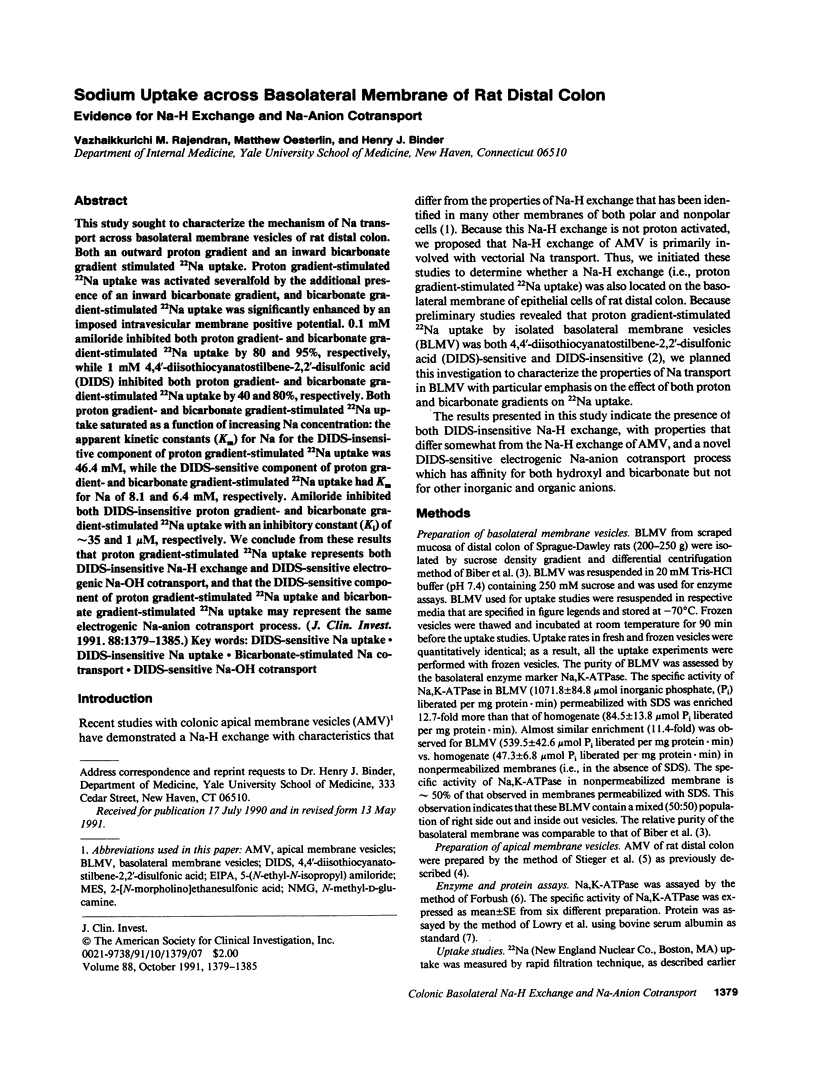
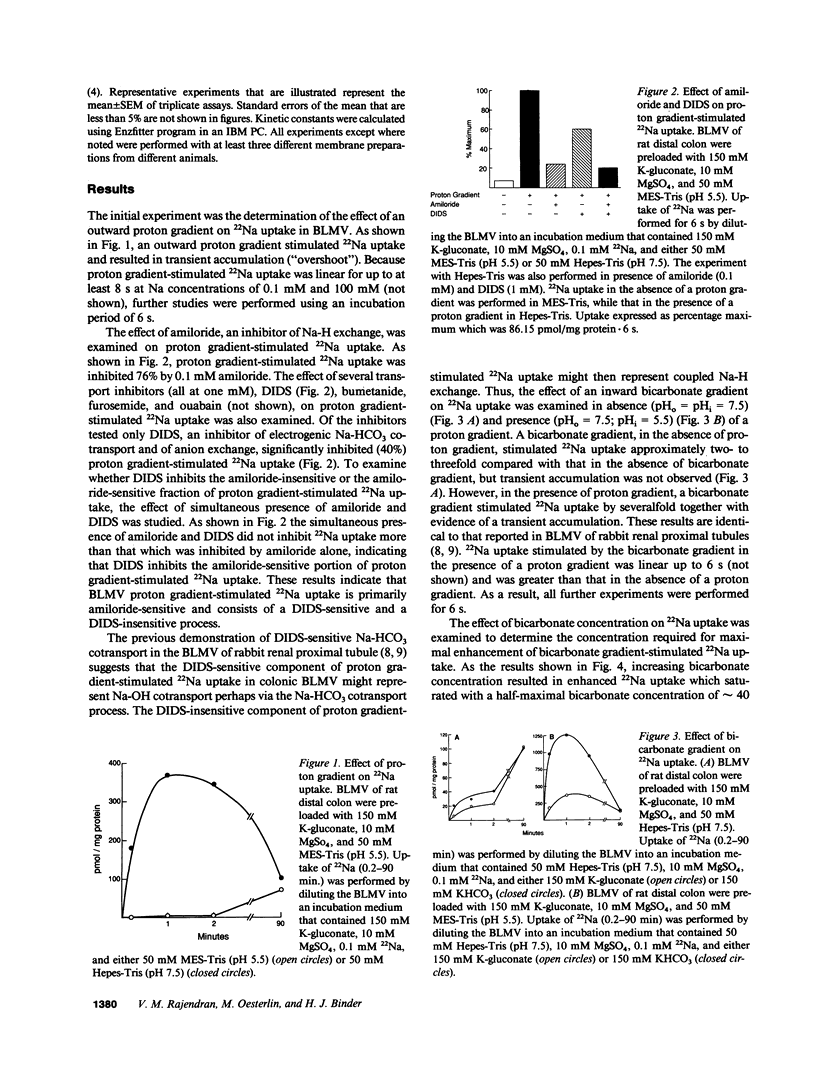
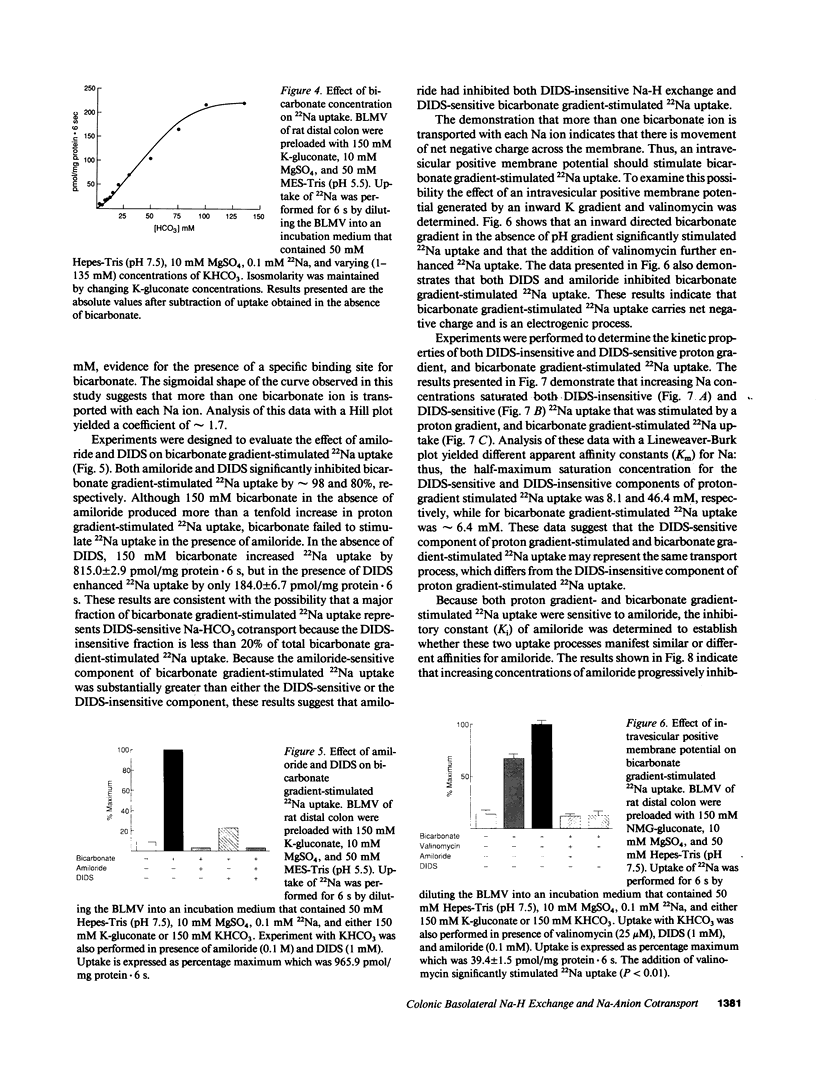
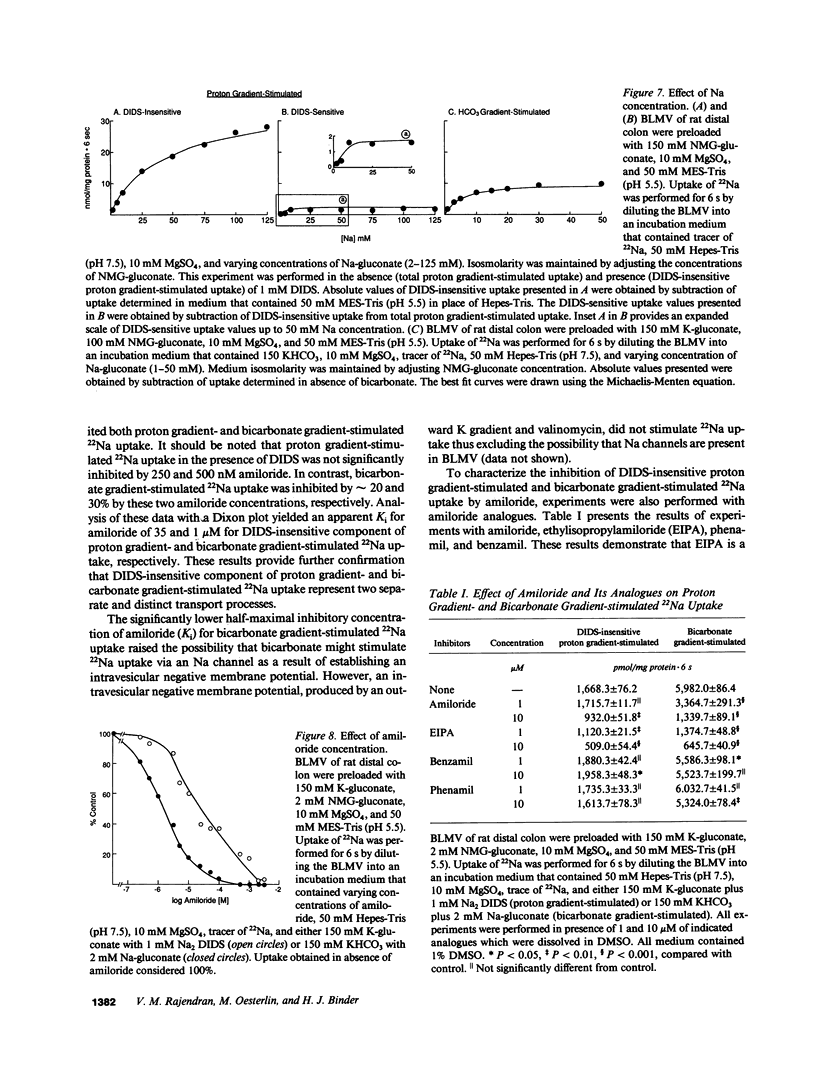
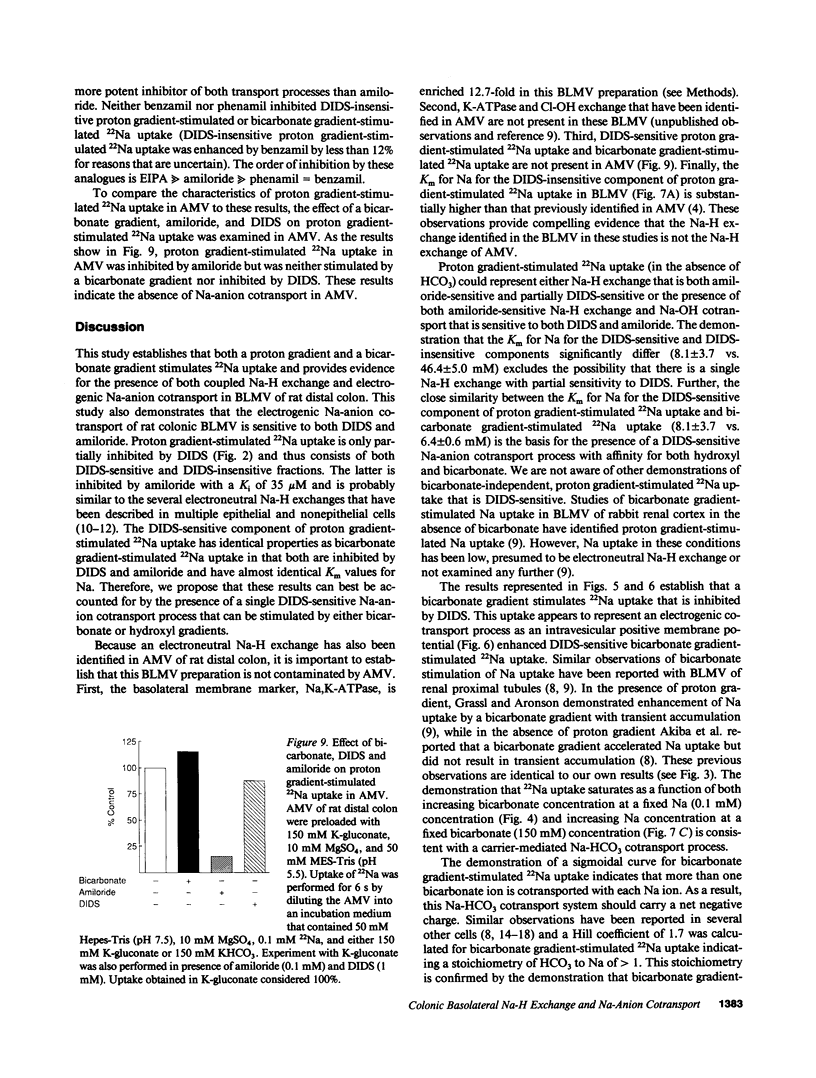
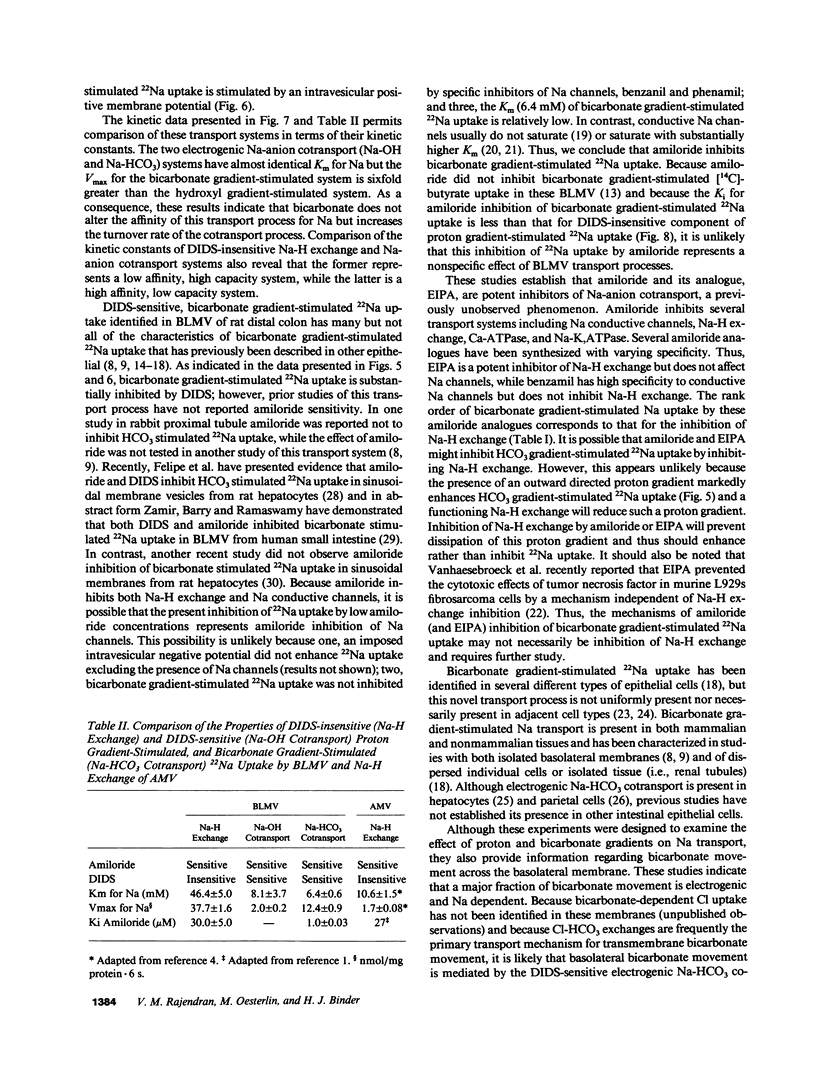
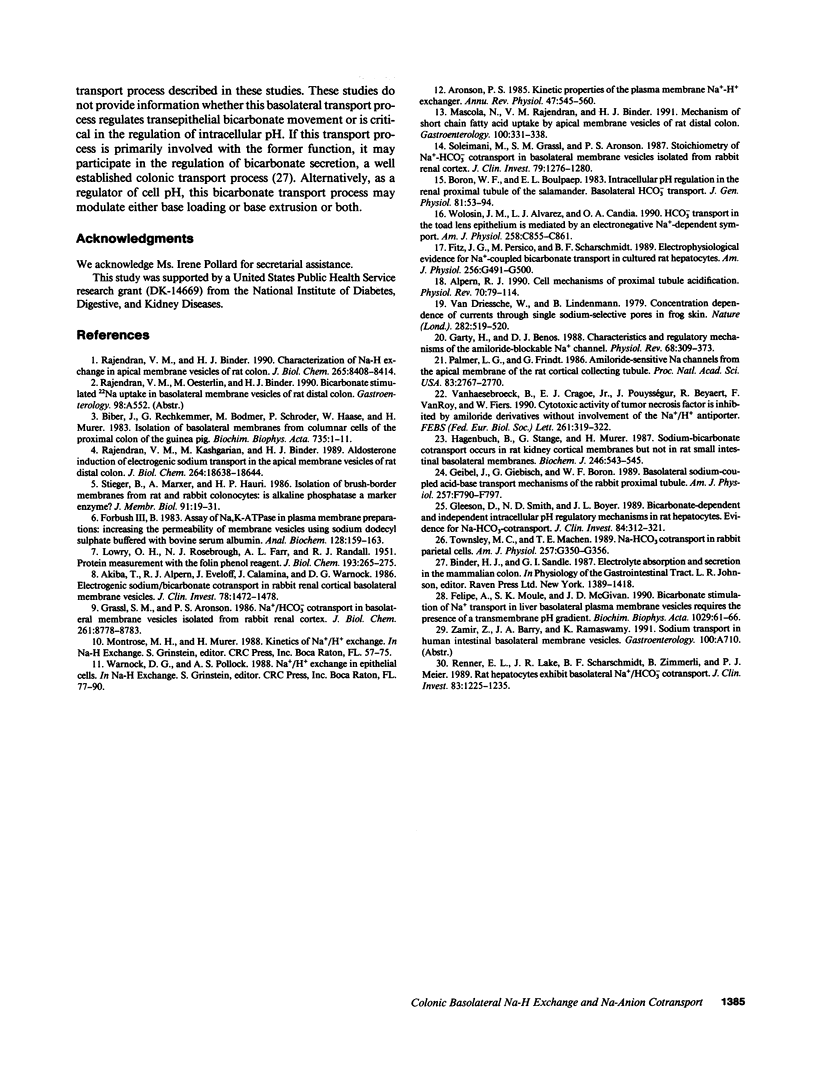
Images in this article
Selected References
These references are in PubMed. This may not be the complete list of references from this article.
- Akiba T., Alpern R. J., Eveloff J., Calamina J., Warnock D. G. Electrogenic sodium/bicarbonate cotransport in rabbit renal cortical basolateral membrane vesicles. J Clin Invest. 1986 Dec;78(6):1472–1478. doi: 10.1172/JCI112738. [DOI] [PMC free article] [PubMed] [Google Scholar]
- Alpern R. J. Cell mechanisms of proximal tubule acidification. Physiol Rev. 1990 Jan;70(1):79–114. doi: 10.1152/physrev.1990.70.1.79. [DOI] [PubMed] [Google Scholar]
- Aronson P. S. Kinetic properties of the plasma membrane Na+-H+ exchanger. Annu Rev Physiol. 1985;47:545–560. doi: 10.1146/annurev.ph.47.030185.002553. [DOI] [PubMed] [Google Scholar]
- Biber J., Rechkemmer G., Bodmer M., Schröder P., Haase W., Murer H. Isolation of basolateral membranes from columnar cells of the proximal colon of the guinea pig. Biochim Biophys Acta. 1983 Oct 26;735(1):1–11. doi: 10.1016/0005-2736(83)90255-9. [DOI] [PubMed] [Google Scholar]
- Boron W. F., Boulpaep E. L. Intracellular pH regulation in the renal proximal tubule of the salamander. Basolateral HCO3- transport. J Gen Physiol. 1983 Jan;81(1):53–94. doi: 10.1085/jgp.81.1.53. [DOI] [PMC free article] [PubMed] [Google Scholar]
- Felipe A., Moule S. K., McGivan J. D. Bicarbonate stimulation of Na+ transport in liver basolateral plasma membrane vesicles requires the presence of a transmembrane pH gradient. Biochim Biophys Acta. 1990 Nov 2;1029(1):61–66. doi: 10.1016/0005-2736(90)90436-r. [DOI] [PubMed] [Google Scholar]
- Fitz J. G., Persico M., Scharschmidt B. F. Electrophysiological evidence for Na+-coupled bicarbonate transport in cultured rat hepatocytes. Am J Physiol. 1989 Mar;256(3 Pt 1):G491–G500. doi: 10.1152/ajpgi.1989.256.3.G491. [DOI] [PubMed] [Google Scholar]
- Forbush B., 3rd Assay of Na,K-ATPase in plasma membrane preparations: increasing the permeability of membrane vesicles using sodium dodecyl sulfate buffered with bovine serum albumin. Anal Biochem. 1983 Jan;128(1):159–163. doi: 10.1016/0003-2697(83)90356-1. [DOI] [PubMed] [Google Scholar]
- Garty H., Benos D. J. Characteristics and regulatory mechanisms of the amiloride-blockable Na+ channel. Physiol Rev. 1988 Apr;68(2):309–373. doi: 10.1152/physrev.1988.68.2.309. [DOI] [PubMed] [Google Scholar]
- Geibel J., Giebisch G., Boron W. F. Basolateral sodium-coupled acid-base transport mechanisms of the rabbit proximal tubule. Am J Physiol. 1989 Nov;257(5 Pt 2):F790–F797. doi: 10.1152/ajprenal.1989.257.5.F790. [DOI] [PubMed] [Google Scholar]
- Gleeson D., Smith N. D., Boyer J. L. Bicarbonate-dependent and -independent intracellular pH regulatory mechanisms in rat hepatocytes. Evidence for Na+-HCO3- cotransport. J Clin Invest. 1989 Jul;84(1):312–321. doi: 10.1172/JCI114156. [DOI] [PMC free article] [PubMed] [Google Scholar]
- Grassl S. M., Aronson P. S. Na+/HCO3-co-transport in basolateral membrane vesicles isolated from rabbit renal cortex. J Biol Chem. 1986 Jul 5;261(19):8778–8783. [PubMed] [Google Scholar]
- Hagenbuch B., Stange G., Murer H. Sodium-bicarbonate cotransport occurs in rat kidney cortical membranes but not in rat small intestinal basolateral membranes. Biochem J. 1987 Sep 1;246(2):543–545. doi: 10.1042/bj2460543. [DOI] [PMC free article] [PubMed] [Google Scholar]
- LOWRY O. H., ROSEBROUGH N. J., FARR A. L., RANDALL R. J. Protein measurement with the Folin phenol reagent. J Biol Chem. 1951 Nov;193(1):265–275. [PubMed] [Google Scholar]
- Mascolo N., Rajendran V. M., Binder H. J. Mechanism of short-chain fatty acid uptake by apical membrane vesicles of rat distal colon. Gastroenterology. 1991 Aug;101(2):331–338. doi: 10.1016/0016-5085(91)90008-9. [DOI] [PubMed] [Google Scholar]
- Palmer L. G., Frindt G. Amiloride-sensitive Na channels from the apical membrane of the rat cortical collecting tubule. Proc Natl Acad Sci U S A. 1986 Apr;83(8):2767–2770. doi: 10.1073/pnas.83.8.2767. [DOI] [PMC free article] [PubMed] [Google Scholar]
- Rajendran V. M., Binder H. J. Characterization of Na-H exchange in apical membrane vesicles of rat colon. J Biol Chem. 1990 May 25;265(15):8408–8414. [PubMed] [Google Scholar]
- Rajendran V. M., Kashgarian M., Binder H. J. Aldosterone induction of electrogenic sodium transport in the apical membrane vesicles of rat distal colon. J Biol Chem. 1989 Nov 5;264(31):18638–18644. [PubMed] [Google Scholar]
- Renner E. L., Lake J. R., Scharschmidt B. F., Zimmerli B., Meier P. J. Rat hepatocytes exhibit basolateral Na+/HCO3- cotransport. J Clin Invest. 1989 Apr;83(4):1225–1235. doi: 10.1172/JCI114005. [DOI] [PMC free article] [PubMed] [Google Scholar]
- Soleimani M., Grassi S. M., Aronson P. S. Stoichiometry of Na+-HCO-3 cotransport in basolateral membrane vesicles isolated from rabbit renal cortex. J Clin Invest. 1987 Apr;79(4):1276–1280. doi: 10.1172/JCI112948. [DOI] [PMC free article] [PubMed] [Google Scholar]
- Stieger B., Marxer A., Hauri H. P. Isolation of brush-border membranes from rat and rabbit colonocytes: is alkaline phosphatase a marker enzyme? J Membr Biol. 1986;91(1):19–31. doi: 10.1007/BF01870211. [DOI] [PubMed] [Google Scholar]
- Townsley M. C., Machen T. E. Na-HCO3 cotransport in rabbit parietal cells. Am J Physiol. 1989 Sep;257(3 Pt 1):G350–G356. doi: 10.1152/ajpgi.1989.257.3.G350. [DOI] [PubMed] [Google Scholar]
- Van Driessche W., Lindemann B. Concentration dependence of currents through single sodium-selective pores in frog skin. Nature. 1979 Nov 29;282(5738):519–520. doi: 10.1038/282519a0. [DOI] [PubMed] [Google Scholar]
- Vanhaesebroeck B., Cragoe E. J., Jr, Pouysségur J., Beyaert R., Van Roy F., Fiers W. Cytotoxic activity of tumor necrosis factor is inhibited by amiloride derivatives without involvement of the Na+/H+ antiporter. FEBS Lett. 1990 Feb 26;261(2):319–322. doi: 10.1016/0014-5793(90)80581-3. [DOI] [PubMed] [Google Scholar]
- Wolosin J. M., Alvarez L. J., Candia O. A. HCO3- transport in the toad lens epithelium is mediated by an electronegative Na(+)-dependent symport. Am J Physiol. 1990 May;258(5 Pt 1):C855–C861. doi: 10.1152/ajpcell.1990.258.5.C855. [DOI] [PubMed] [Google Scholar]





